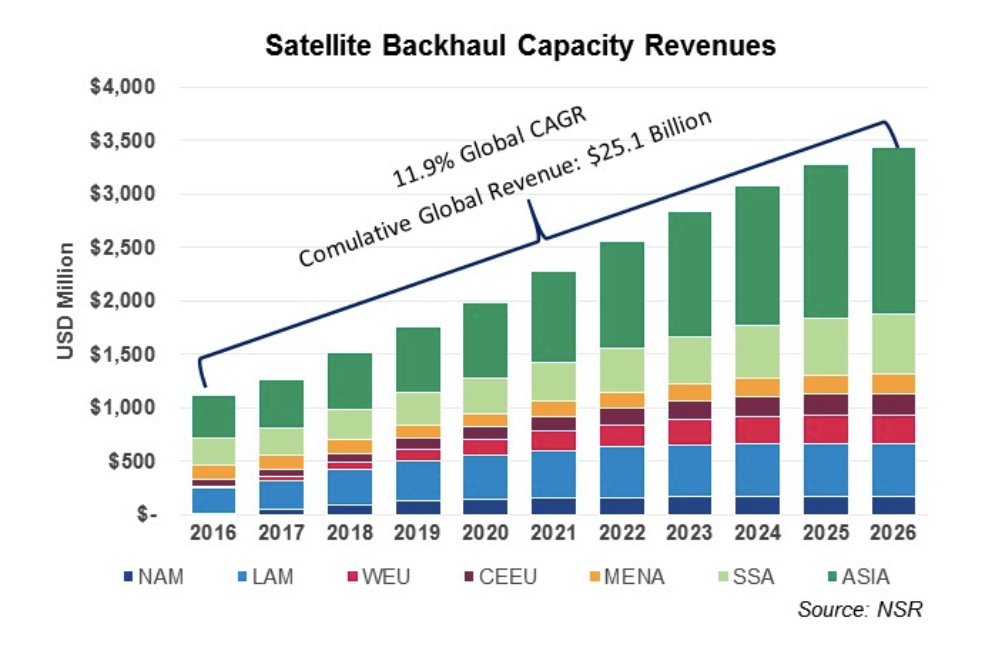Satellite
Backhaul ‘As a
Service’
Jun 21 2017
by
Lluc
Palerm-Serra,
NSR
Mobile
Infrastructure is
changing rapidly,
both technologically
and business wise.
Introduction of new
concepts like
SDN/NFV arrive with
new business models
in which
equipment and
infrastructure are
now offered “As a
Service”.
What are the
implications for
satcom, and how can
the satellite
industry capture
growth in this new
environment?

Backhaul will be one
of the key drivers
for satellite
industry growth in
the coming years.
Growth in the active
base, appearance of
new use cases or the
transition to
broadband services
all will boost
demand. According to
NSR’S Wireless
Backhaul via
Satellite, 11th
Edition report,
capacity
revenues alone will
grow from under $700
million in 2016 to
over $2.8 billion in
2026. More
importantly, mobile
operators are
willing to
externalize network
management services,
which multiplies the
size of the business
that can be
extracted from
deployments to
unprecedented levels
in the satellite
industry.
Everything ‘As a
Service’
Mobile operators
globally face
revenue growth
stagnation, and in
order to keep
margins, operators
are looking at
strategies to gain
efficiencies. At the
same time, several
factors such as
debt-heavy balance
sheets or the need
to be responsive to
recent technology
trends and market
dynamics make MNOs
more risk averse and
willing to
transform CAPEX
investments into
OPEX. This
has created entirely
new markets such as
the Towercos
businesses
(management of
mobile towers),
which in some
regions like Latin
America or Africa
own close to 50% of
the total towers.
This move towards
‘Everything as a
Service’ will only
accelerate with the
introduction of
innovative network
conceptions like
SDN/NFV. Services
are now penetrating
into the core
functionalities of
mobile operators,
for example, with
the recent deal
between Tigo Rwanda
and Ericsson to
provide BSS
functions ‘as a
Service’ (charging,
billing,
provisioning,
mediation, roaming,
etc.). All in all,
MNOs are
more willing to
outsource
infrastructure
management and focus
on the
customer-facing core
competences.
Satellite requires a
very particular
skillset.
Traditionally,
satellite was
relegated to a niche
role serving
government
obligations in rural
locations. Few
operators relied on
satellite to
backhaul traffic,
and those MNOs
generally deployed
and managed the
networks internally,
acquiring the
necessary equipment
and skills. However,
with the need to
continue extending
broadband coverage
to remote areas and
the emergence of new
use cases, satellite
is becoming another
tool in the backhaul
technologies mix.
If the
satcom industry
wants to play a
bigger role in the
backhaul ecosystem,
it needs to develop
a service offering
that facilitates the
adoption of
satellite backhaul.
Satellite End-to-End
Solutions
This trend towards
‘infrastructure as a
service’ is also
gaining momentum in
the satellite
industry. This
allows satcom to
offer services to
mainstream mobile
operators without a
background in
satellite
technologies.
Examples of such
deployments include
the Managed Rural
Coverage deal
between Ericsson and
MTN to provide
mobile coverage for
a set period
according to service
level agreements and
key performance
indicators, or the
recently announced
deal between
Speedcast and Wasel
Telecom for fully
managed
connectivity.
The revenues that
can be extracted
from these kinds of
deployments are much
higher than what was
seen in the past for
the satellite
industry. Not only
do new deployments
involve larger
capacity
requirements and
smarter terminals,
they also require
end-to-end
integration of RAN
equipment, energy
supply, towers,
etc.; growing the
total deal size for
system integrators.
The Role of
Governments
No one questions the
benefits of
connectivity for our
societies. One of
the latest studies
from The World Bank
highlights that a
ten percent increase
in broadband
increases GDP per
capita by USD13,036.
Governments around
the world have tried
to stimulate
broadband expansion
through USF/USO
programs with
diverse outcomes.
Most of the time,
the critical
challenge in these
programs is ensuring
the long-term
sustainability. Some
governments are
pursuing innovative
approaches to
incentivize private
investment in rural
areas to ensure
economic viability
and minimize public
economic burden.
One promising
example is the new
entity created by
the Peruvian
government, Rural
Infrastructure
Mobile Operator.
These entities do
not serve final
customers and do not
own radio access
spectrum but offer
backhaul and
infrastructure to
regular mobile
operators. These
rural operators have
certain obligations
in terms of quality
of service, but they
also have important
advantages to
protect their
investments like the
obligation from
Mobile Operators to
buy services from
them and some
protection against
MNO’s own network
expansion. While the
concrete results of
such implementation
are still uncertain,
the
satellite industry
must develop
wholesale offers
that can help mobile
operators achieve
their objectives of
network expansion.
Bottom Line
The way mobile
operators build
their networks is
changing radically
with the adoption of
concepts like
SDN/NFV and new
business models like
‘Infrastructure as a
Service’. This is
having an immediate
impact also in the
satellite industry.
As satcom attracts
more mainstream
mobile operators
without internal
satellite skills,
the industry needs
to develop wholesale
offers that can meet
the needs of those
mobile operators.
Furthermore, this
will have a positive
outcome for systems
integrators as the
size of deployments
is growing with
end-to-end
solutions.
Governments still
have a key role to
play in the
expansion of
broadband coverage.
While some USF/USO
programs have
long-term viability
issues, ensuring a
‘friendly’
legislative
environment that
incentivizes and
protects investments
can make a big
difference in
stimulating
broadband expansion.






